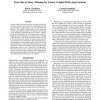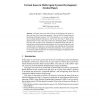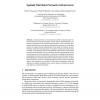89
Voted
ATAL
2008
Springer
15 years 2 months ago
2008
Springer
Recent advances in technology allow multi-agent systems to be deployed in cooperation with or as a service for humans. Typically, those systems are designed assuming individually ...
102
click to vote
AIPS
2008
15 years 2 months ago
2008
Loosely coupled multi-agent systems are perceived as easier to plan for because they require less coordination between agent sub-plans. In this paper we set out to formalize this ...
AAAI
2007
15 years 2 months ago
2007
In multi-agent systems, agents need to share information in order to make good decisions. Who does what in order to achieve this matters a lot. The assignment of responsibility in...
120
click to vote
CISIS
2010
IEEE
15 years 4 months ago
2010
IEEE
— Production automation systems consist of many entities (like robots and shuttles) that interact in complex ways to provide the overall system functionality like product assembl...
103
Voted
ATAL
2003
Springer
15 years 4 months ago
2003
Springer
Debugging multi-agent systems, which are concurrent, distributed, and consist of complex components, is difficult, yet crucial. In earlier work we have proposed mechanisms whereby...
GECCO
2006
Springer
15 years 4 months ago
2006
Springer
In this study, we investigate self-organizing social hierarchies in multi-agent systems. Agents occupy the nodes of a smallworld network and interact exclusively with other agents...
133
click to vote
ESAW
2006
Springer
15 years 4 months ago
2006
Springer
Abstract. This paper surveys the state-of-the-art in developing multi-agent systems, and sets out to answer the questions: "what are the key current issues in developing multi...
144
click to vote
ECMDAFA
2006
Springer
15 years 4 months ago
2006
Springer
Abstract. Design patterns are templates of general solutions to commonlyoccurring problems in the analysis and design of software systems. In mature development processes, engineer...
92
Voted
ECAI
2006
Springer
15 years 4 months ago
2006
Springer
In this paper, we show how to establish correctness and time bounds (e.g., quality of service guarantees) for multi-agent systems composed of communicating rule-based agents. The f...
114
Voted
E4MAS
2006
Springer
15 years 4 months ago
2006
Springer
Abstract. In previous works we have presented a model to describe and simulate environment for situated multi-agent systems, that we called ELMS. Here, we present an extensions to ...







